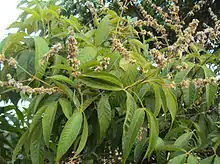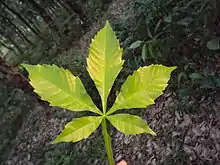Vitex altissima
Vitex altissima, the peacock chaste tree, is a species of woody plant reaching some 20 m in height, in the family family Lamiaceae. It is native to the Indomalayan realm, namely Bangladesh, India, Indonesia, Myanmar, and Sri Lanka, and is also found in New Guinea.[2] Its greyish bark becomes scaly with maturity. The leaves are trifoliolate or palmate, compound and opposite. They are elliptic or elliptic-lanceolate in shape with acuminate apex and cuneate base. The margin is serrate or sometimes entire. The inflorescences are in terminal panicles. The corolla is bluish white. The purplish black fruit is a four-seeded drupe.[3]
| Peacock chaste tree | |
|---|---|
 | |
| inflorescences and trifoliolate leaves | |
 | |
| upper side of palmate leaf | |
| Scientific classification | |
| Kingdom: | Plantae |
| Clade: | Tracheophytes |
| Clade: | Angiosperms |
| Clade: | Eudicots |
| Clade: | Asterids |
| Order: | Lamiales |
| Family: | Lamiaceae |
| Genus: | Vitex |
| Species: | V. altissima |
| Binomial name | |
| Vitex altissima L.f. | |
| Synonyms | |
| |
| Wikimedia Commons has media related to Vitex altissima. |
Common names
- Tamil – Mayilei, Mayilainochi, Mayiladi
- Malayalam – Myila, Mylellu
- Marathi – Dhavi-rivthi, Balage
- Telugu – Ganduparu, Nemiliadogu
- Kannada – Myrole, Nevaladi, Navuladi, Balgay
- Sinhala – Milla (මිල්ල) [4]
- English – Peacock chaste tree, Tall chaste tree
- Assamese – Ahoi (অহোঈ )
- Sanskrit – Atulam (अतुलम्), Tilakam (तिलकम्)
- Nepali – Tin-patte [5][6]
References
- "Vitex altissima L.f. — the Plant List".
- http://indiabiodiversity.org/species/show/31884
- "Vitex altissima - VERBENACEAE".
- Liyanage, Sunil (2013). "NATURAL DISTRIBUTION OF Vitex altissima IN SRI LANKA". Proceedings of International Forestry and Environment Symposium. 0. doi:10.31357/fesympo.v0i0.1373.
- "Vitex altissima - VERBENACEAE".
- "Vitex altissima - Peacock Chaste Tree".
- Flavonoids, triterpenoids and a lignan from Vitex altissima.
- New acylated iridoid glucosides from Vitex altissima.
- Phytochemical Analysis of Vitex altissima.
This article is issued from Wikipedia. The text is licensed under Creative Commons - Attribution - Sharealike. Additional terms may apply for the media files.